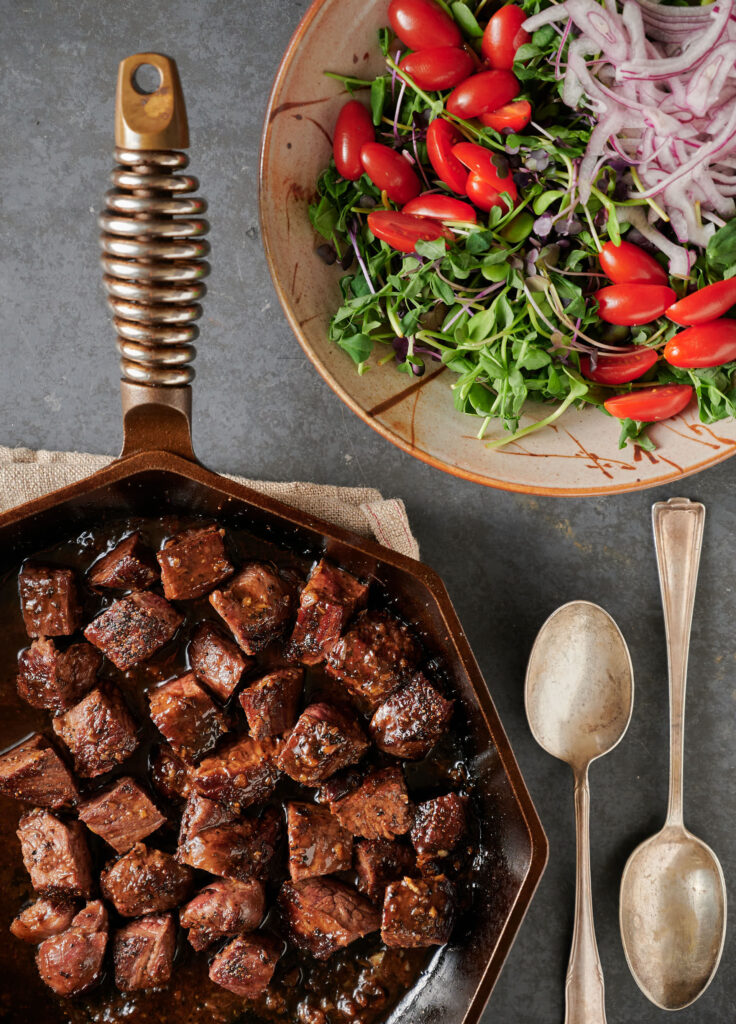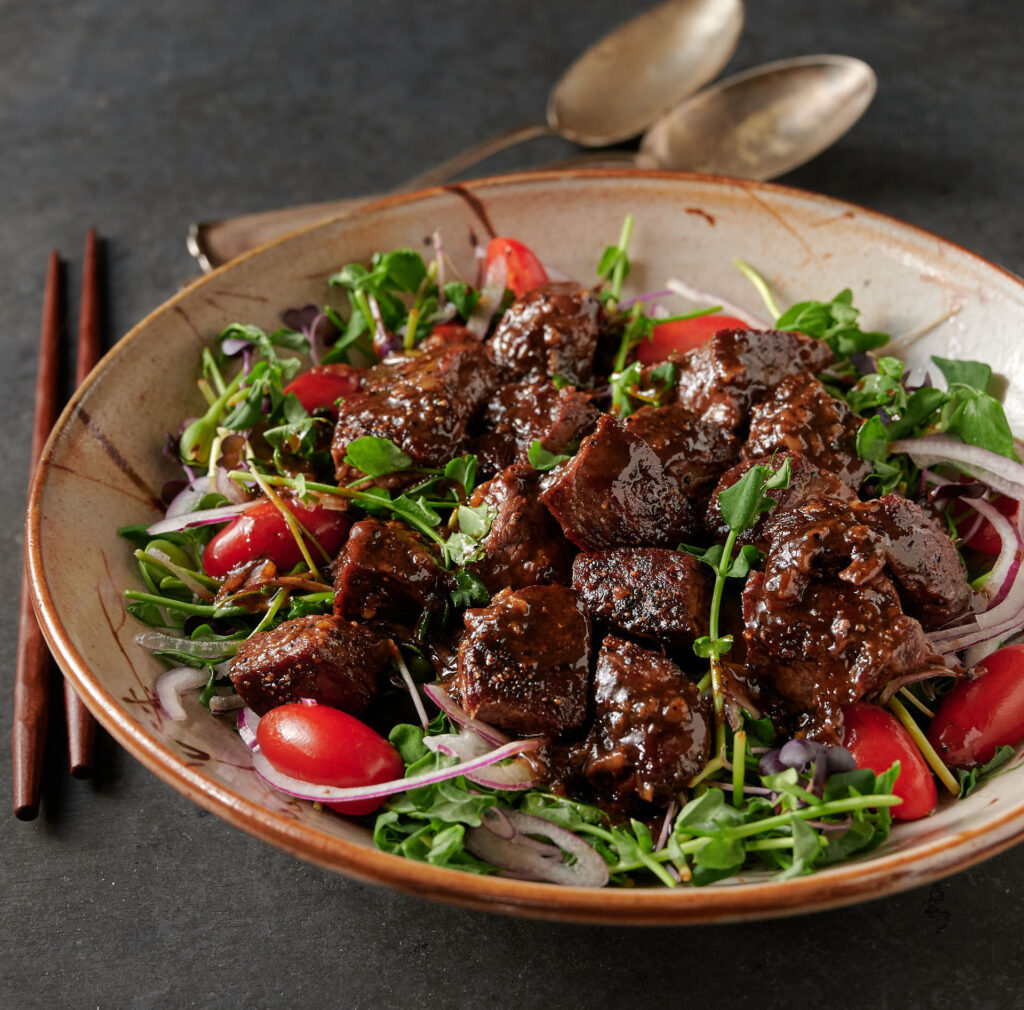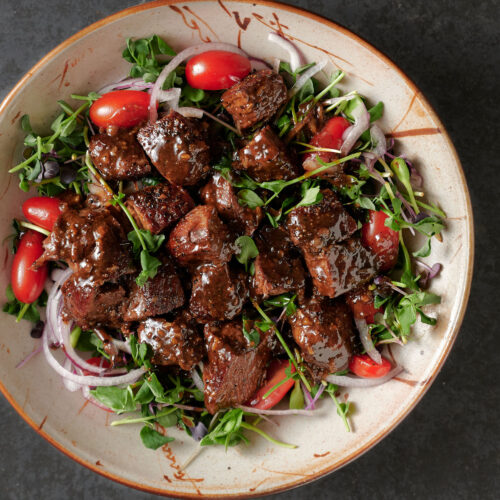Shaking beef needs to be browned
There is a name for that browning you get when you fry beef. It’s called the Maillard reaction. And that reaction is a wonderful, wonderful thing.
It’s food science. Chemistry. Amino acids and reducing sugars hit heat. And magic happens. Millions of new flavour compounds are created.
You don’t need to understand it. But you do need to believe in it. And you must ensure that it occurs in your pan.
Because of this, I don’t often receive recipes for shaking beef. I see marinate cubes of beef. Get them good and wet. Then dump it in a pan.
When I try that I get steamed beef. If I cook the beef to death, it will probably be grey beef with some browning. Not what I’m after at all.
Wet, cubed beef is not good for Maillard. When browning beef for stew, consider not crowding a pan.
You get browning. Eventually. when the beef’s released liquid has completely evaporated Not great. However, you can manage because it is irrelevant how long the beef is cooked in the pot. It’s stew.
The beef is going to get braised for hours. Thus, you need not be concerned about the pot being overcooked. Thing is, it does matter for shaking beef.

Cook a steak – then make bo luc lac
I keep the beef in 8-10 oz size pieces when I want the most Maillard. Steaks. And I salt at the last possible minute. Right before it goes into the pan.
Salting at the last minute is important. Think dry brining. As soon as you add salt, water is drawn out and deposited on the meat’s surface.
That’s osmosis. More food science. The process reverses after a while. That’s how dry brining works. But if it’s still wet, don’t put it in the pan. So salt at the last minute. You want as dry as you can get here.
Here, you won’t get uniform browning like you would with cubes. That’s true. I believe that two sides executed well are preferable to six sides of mediocre.
Plus you control how done the beef gets. Want medium rare? Stop at just before medium rare. Just remember an instant read thermometer is your friend here.
Cut your steak into bite-sized pieces once it has reached your desired doneness. You want comfortable bites here. Not big chunks. Unless, of course, you really want to practice the Heimlich maneuver.

Add the sauce to the cooked beef
Please save the sauce for the very end if you do decide to cut your beef before cooking. To maximize browning, follow the recipe with a steak (better) or cubes (if you must).
There’s another benefit to doing this way. You get a fond when you cook beef in hot oil. It’s gold, that brown material at the bottom of the pan. There’s all sorts of flavour there.
Cook the beef. Add the garlic and sweat it a bit. And then deglaze with the sauce. Scrape up that gold. Don’t leave it behind. Get that flavour into your dish.
Choice of oyster sauce matters for shaking beef
I may not be popular for saying this. But I really prefer Thai oyster sauce. For any recipe that isn’t Chinese anyway.
The flavour profile is different. I find it less salty. Less in your face. It doesn’t overpower. Just complements the dishes you use it in.
I couldn’t stand oyster sauce for years. Didn’t even stock it in my fridge. Until I discovered Thai oyster sauce. Now I always have it on hand.

Bo luc lac meets food science
This is beef shaken with a dash of food science. It’s a different approach for sure. Not your mom’s bo luc lac.
It’s how I like it though. I’m always after big, bold flavours. Try it. If you like it, let your mom know.

shaking beef – Vietnamese thit bo luc lac
- 1 lb beef cut into whole steak-size pieces, such as a ribeye, New York, or filet mignon. Dont cut it into cubes yet.
- salt to season the beef
- 1 teaspoon of black pepper (e.g., butcher’s blend) You want to liberally sprinkle semi-coarsely ground pepper on the beef.
- 3 cloves garlic – minced
- When adding the garlic, add 2 tbsp vegetable oil plus a little bit more if the pan is dry.
- 2 tsp dark soy Thai sweet soy preferably
- 1 1/2 tbsp oyster sauce Thai preferably (strongly recommended really)
- 1 tbsp fish sauce
- 2 tbsp mirin
- 1-2 teaspoons of sugar, or even more if you like your food a little sweet
- 2 tsp sesame oil
- After deglazing the pan, mix 1 tablespoon of rice vinegar to taste with the hot sauce.
- 3 cups watercress or baby greens of your choice.
- 1/4 cup red onion thinly sliced
- Go with the best you can find with the 1/2 cup of cherry tomatoes that have been cut in half (grape tomatoes and thinly sliced regular tomatoes are also fine).
- a little drizzle of vegetable oil
- Prepare your greens, red onion and tomatoes. Set aside.
- Combine the all sauce ingredients in a small bowl. You will be deglazing your pan with this sauce.
- Over medium-high heat, preheat a large frying pan that can accommodate the steaks in a single layer. Add the oil. Season the steaks liberally with salt and pepper just before you start frying them.
- Turn on your ventilation fan. This is going to smoke.
- Fry the beef in the pan for three to four minutes. You want a nice crust on the beef. This should get you to about medium rare. depends on the thickness of your steaks and the heat of your pan. I simply don’t know your specific details, so I can’t be more specific.
- Flip the steak and cook it another 3 minutes. Remove and let rest around 10 minutes. Check your internal temperature. 125F is rare. 130 is medium rare. Remove the pan from the heat.
- Cut the beef into large, bite-sized chunks after the steak has rested for 10 minutes.
- Return the pan to medium low heat. Keep an eye on it. You dont want your fond to burn. Add the garlic after it has heated up and cook for about 30 seconds.
- Increase the heat and use the sauce to deglaze the pan. Scrape up all of that delectable brown gold, then stir it into the sauce.
- Once the pan has been thoroughly deglazed, reduce the heat to low. Taste it. Now start adding the rice wine vinegar. A good acid-salt balance is what you’re after. Creep up on it.
- Return the beef to the pan once you’ve reached the point where you’re satisfied with the sauce (which is really your vinaigrette). Heat through gently. You dont want it to cook more. Just warm it up.
- To serve spread your greens out on a plate. Top with onions and tomatoes. Drizzle with a bit of vegetable oil. Add the beef to this mixture and drizzle some sauce over it. Serve with lime wedges. Plate individually or as a communal appetizer.
Not to brag but I think my shaking beef recipe is THE BEST HANDS DOWN!!!
FAQ
How do you say shaking beef in Vietnamese?
Bò lúc lắc is one of my favorite dishes. Because you cook steak by shaking the cubes around in the pan, the Vietnamese word for it is “shaking beef.” I adore this recipe because it gives your steak so much flavor and allows you to stretch a steak to feed two or three people.
What is shake meat?
Vietnamese Shaking Beef is cubed steak that has been seared and sauteed with butter, garlic, onion, and a soy marinade. The beef is served with an optional lime-salt-and-pepper dipping sauce and is placed on a bed of lettuce, watercress, tomato, and/or cucumbers.
Where did bò lúc lắc come from?
Traditional Southeast Asian beef dish from Vietnam, B Lc Lc
Is Lok Lak Cambodian or Vietnamese?
The main ingredients in lok lak, a Cambodian stir-fry, are beef, chicken, or shrimp, although beef is typically the most popular choice.
